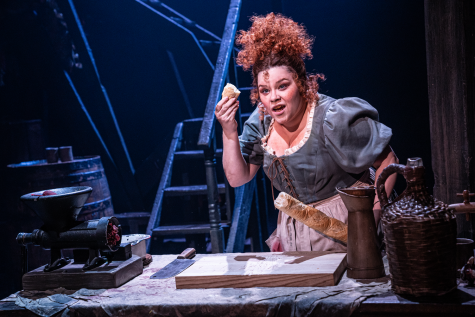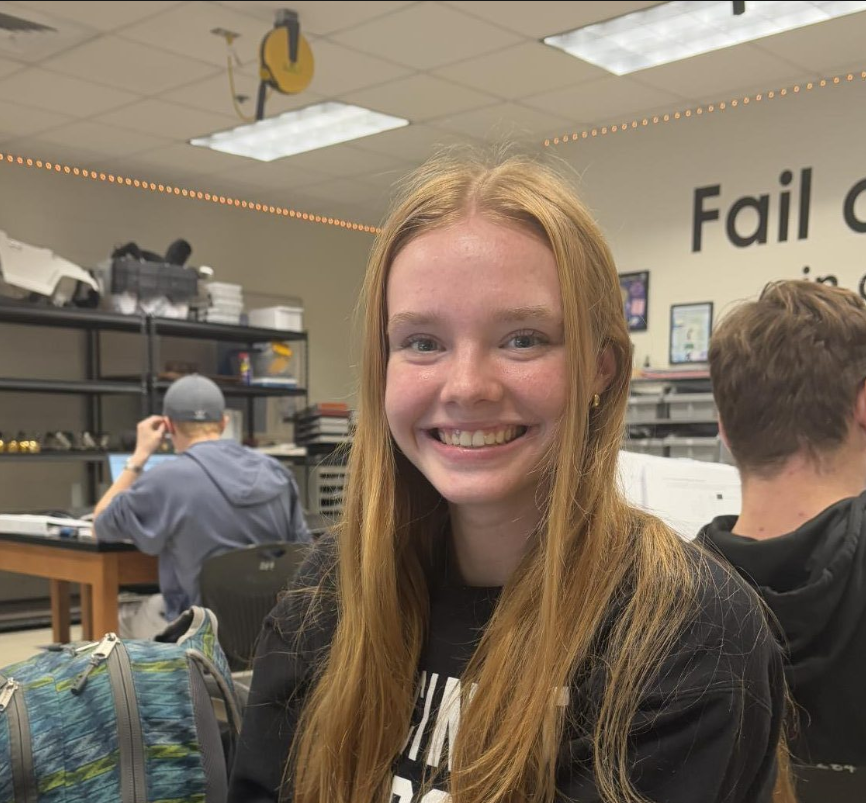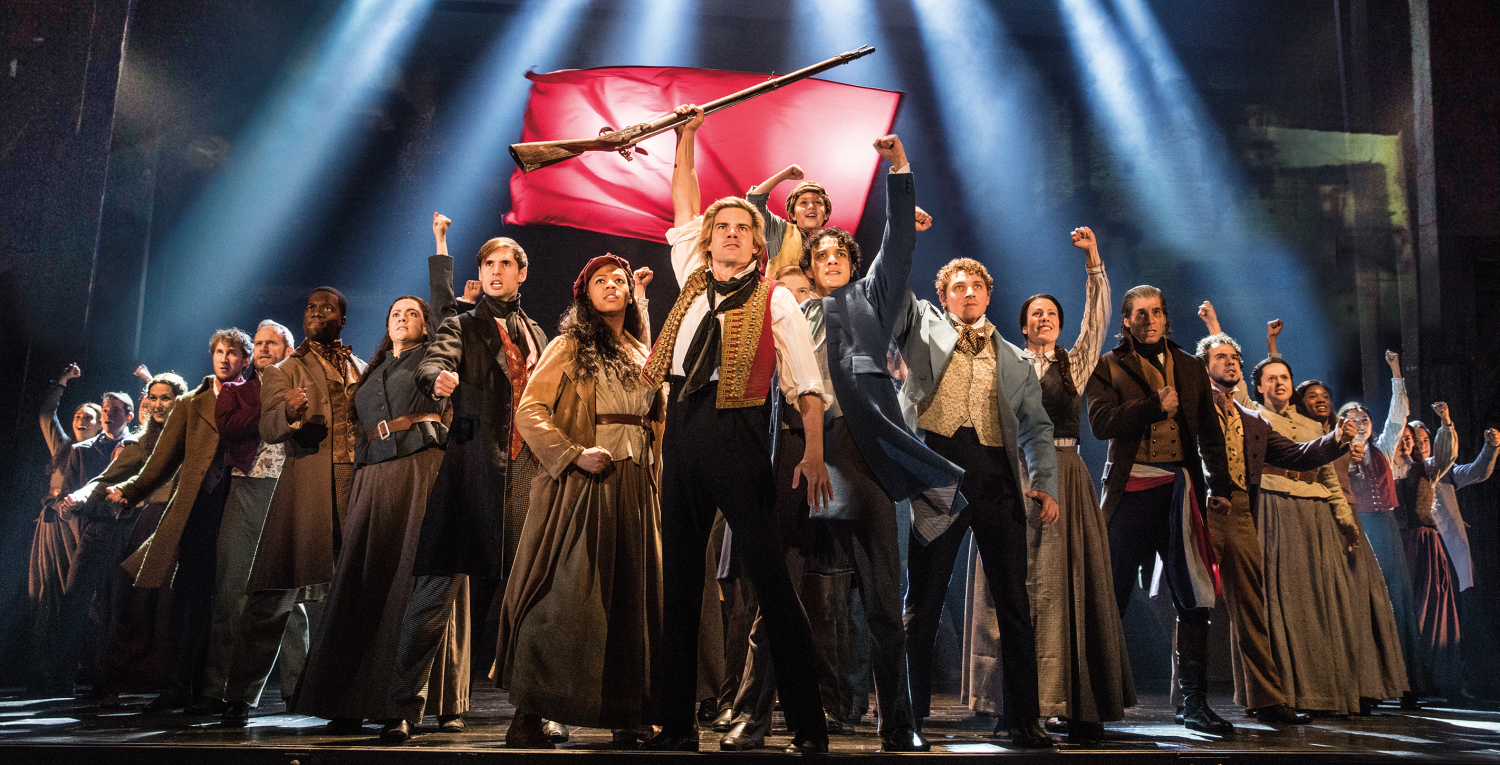story by Anna Mullins | photography by Isis Summerlin and Fair Use
A small group gathers on the sidewalk patiently waiting. Excitement builds as the first few actors step out the stage door entrance. The first round of actors includes the children of Les Mis, with their scooters and helmets, all eager to sign playbills. Then emerges an actress with teal tipped hair and a huge smile, Michelle Dowdy.
Dowdy who has played Tracy Turnball on Broadway, currently plays Madame Thénardier in the US tour production of Les Misérables. As Dowdy emerges from the stage door it is hard to imagine the 33-year-old as the middle aged bawdy innkeeper’s wife that the magic of theater makeup allows her to play on stage.
“This is a part that I thought I’d have to wait many years to play, to be honest,” Dowdy says. “But you know, you get me all uglied up and I look great. So apparently age is not a thing.”
Dowdy has been a fan of Les Misérables for years, and had been auditioning for the cast for the past three years. The first and second year she auditioned for the female ensemble track, which includes the Madame Thénardier role. The third year she was asked to audition specifically for Madame Thénardier. According to Dowdy, acting is a number game and not every audition works. Oftentimes an actor can go to 500 auditions before booking that one job.
“I love my job. I feel really lucky that I get to do this,” Dowdy told Spark. “I’ve worked really hard for many years and I’ve hustled, doing gigs here, gigs there. I couldn’t be more grateful to have something like this to be my job. Especially something that’s as epic as Les Mis.”
Dowdy joined the Les Misérables cast in December 2019 at same time as Preston Truman Boyd, “Inspector Javert”, and Patrick Dunn, “Jean Valjean”. According to Dowdy, while newly casted actors usually get two weeks, she learned her part in two days and was ready to be in front of an audience to practice her comedic timing. She felt fortunate to be joining the cast at the same time because they got to use the orchestra for their combined put in dress rehearsal.
“Because it was such a big principle heavy put in, we got to use the orchestra. Usually you just get the rehearsal piano in the pit,” Dowdy says. “We got the full orchestra this time, which is very nice when you only get two weeks.”
As the orchestra begins to play, Victor Hugo’s “Town at Dusk”, projected amongst the scenery of post-Revolutionary France, transforms almost instantaneously into the realistic imagery of a prison labor boat with prisoner 24601. From Victor Hugo’s publication of “Les Misérables” in 1862 to its premiere production on the stage in 1985 and finally to its revamp in 2010 Les Mis has been astounding its audience.
When Les Mis was first brought to the London Barbican Theatre it was acted out on a turntable that revolved as the scene changed, which was a common set design at the time. The 25th anniversary redesign gets rid of the turntable and instead incorporates projection technology, which includes some of Victor Hugo’s own paintings.
Matt Kinley, a veteran set designer with 30 years experience, was approached in 2009 by producer Cameron Mackintosh to redesign sets for the 25th anniversary production of Les Misérables. According to Kinley, the biggest challenge of the redesign was removing the revolve, while still illustrating scenes and keeping the fluidity of the show.
“The projection we employed was the tool we used to drive the narrative and tell the audience where we were whilst never being too literal,” Kinley told Spark. “The projection gave us an impressionistic layer which added colour and light into the show.”
According to Kinley, who has worked on well known shows such as Miss Saigon and Mary Poppins, his role as a set designer is to illustrate the narrative of the piece using whatever format suits the production the best.
“I have to work creatively with the director and the rest of the team to establish a language for the show,” Kinley says. “And then deliver that through the use of scenery, video, etc. for all the scenes in the production.”
In previous productions the revolve moved constantly to give the feel of motion. In the new production projection changes continuously to give that same feel. According to Kinley, there have been many advancements in projection, LED screens, moving lights, and automation, but they must be used carefully.
“Projection has an important and ever increasing role to play on the stage but needs to be handled carefully,” Kinley says. “Used at it’s laziest then it’s terrible cheap scenery and at its best is an integral and often beautiful facet of the production.”
Victor Hugo was well known as a novelist and poet, and less known as a painter who worked in watercolor and charcoal techniques. Some of Hugo’s works were taken in their entirety while others are used in montages or combined with filtered 19th century photography.
“Unfortunately for me Hugo didn’t illustrate every scene,” Kinley says. “ Instead I went through his catalogue of 4000 sketches and paintings and used what I thought was appropriate for the piece, as many were too fantastical or caricatured.”
According to Kinley, the best projection design doesn’t shout about itself and instead of being distracting is another layer in the show. The projection allows the illustration of large sections of story to be crammed into short amounts of time.
“My favourite part of the show is none of the big scenic moments like Paris, the Barricades or Javert’s suicide,” Kinley says. “But scenes where we layer the whole stage with projection, scenery, smoke and lighting to look like a painting in itself, like the Docks for Fantine’s arrest or the death of Eponine.”
According to Kinley, the recent West End version of Les Misérables uses every scenic technology both old and new from wood, paint and canvas to cutting edge laser projectors and sophisticated automation. It’s a period piece and now that it has a classically orchestrated score, the aesthetics needed to feel similarly timeless.
Founding Director of 59 Productions Leo Warner was part of the creative team that helped to realize the projections for the Les Misérables redesign. According to Warner, video projection technology, stage organization, and animatronics are the specific advantages of the past 10 years, but set design has always heavily engaged technology.
‘One of [Leonardo da Vince’s] favorite art forms was not painting or engineering, it was theater design,” Warner told Spark. “So I think there’s always been a fascination with the mechanics of creating an environment that can tell a storyline on stage.”
With projection there are several factors that can affect the effect that the design will have on the audience. If the lighting on stage is too dark the scenic landscape of the projection may be easily seen, but the performer’s facial expressions hidden, and the opposite is true if the lighting is too bright.
“So you’ve got to work incredibly closely, hand in hand between those parts.” Warner says. “Sound, light, projection and set all need to work pretty seamlessly together in order for a production to be any good.”
According to Warner, the lighting used for Les Misérables matched the feel of Victor Hugo’s watercolor paintings being projected, as designed by Kinley. They created one coherent picture with a delicate balance between light and projection.
“It is a very dark set,” Warner says. “So it’s quite hard sometimes to work out how deep the scenes are and get some lovely projected skylines and backstage which feel like they could be sort of really far away.”
One of the transitions that works flawlessly, is a scene where two characters are struggling to escape the barricade through the sewers. They walk through a small grate on the side of the stage, and then the entire scene transforms showing them walking through the sewer while the background changes to make it appear as though they are moving within the stationary set.
“I’m as proud of the scene changes as the scenes themselves,” Kinley says. “The transitions are usually so quick and fluid–people have no idea how the stage has changed in an instant.”
Tony-nominated costumes by Andreane Neofitou were also part of the 25th anniversary redesign. In order to be authentic, Dowdy’s costume has multiple layers that would have been expected during that time period as well as a Marie Antionette style wig that she wears at the end of the show. According to Dowdy she arrives about an hour early to start her hair, which she puts up in preparation for the head wig person to complete. After she has her wig on, Dowdy begins the process of donning her many layers of clothing, tights, camisole, bloomers, corset, and petticoats.
“I have to be dressed in my tights and be in a little camisole and my special underwear and all this, before I even get into the corset,” Dowdy says. “They’re good about being really authentic, which is why I have to wear the bloomers on top of the corset.”
Dowdy plays the bawdy innkeeper’s wife Madame Thénardier. The Thénardiers act as the comic relief within Les Misérables’ dark 19th century France. According to Dowdy her track in the show is totally different compared to the other roles. While other characters are having heartfelt moments Madame Thénardier seems immune to the sadness. Even Thénardier, played by Jimmy Smagula, has an epiphany during a dark moment in the sewers as he pulls gold teeth from dead bodies. Conversely, the next time you see Madame Thénardier she is dancing and gorging on cake in the act two wedding scene.

the style of clothing at the time of the French Revolution in which her character, Madame Thenardier lives in.
“Fantine dies, little Cosette is singing “Castle on a Cloud,” and then here I come. It’s a complete shift of energy,” Dowdy says. “I think the audience needs to laugh. They need a moment to be like, ‘Oh God, everything’s so terrible’, ‘Oh wait it’s not’. It is, but now you can at least relax for a second.”
While Dowdy’s character Madame Thénardier is entirely comic relief, the actress herself echoes Les Misérables’ call to compassion and hope for those facing adversity. She is a passionate advocate for Broadway Cares/Equity Fights AIDS, a nonprofit fundraising organization that draws upon the talents, resources and generosity of the theatre community.

“I’ve been working with them ever since I moved to New York,” Dowdy says. “When I was in Hairspray, I was doing Broadway Bares, which is a big burlesque show that [Broadway Cares] does every year.”
According to Michael Di Bianco, the educational outreach coordinator of Broadway Cares/Equity Fights AIDS, the original goal of the organization was specifically to help HIV and AIDS organizations, but the mission has since expanded to helping over 450 social service organizations across the country. The organization now gives grants to both national and local charities such as food banks, women’s health initiatives, and disaster relief.
“So our purpose is more of a fundraiser and giving grants,” Di Bianco says. “So that smaller organizations and communities across the country can thrive and stay open and help their clients get the things that they need.”
According to Di Bianco, the biggest fundraiser is the six week red bucket appeals that occur twice a year. All of the Broadway shows and national tours across the country participate and compete to see who can collect the most donations.
“For six weeks all Broadway shows are doing red bucket appeals to collect donations,” Di Bianco says. “It’s kind of like a fun competition between shows of who can raise the most money and some shows really go full out with their creativity of how they want to raise their funds.”
According to Dowdy, she and Smagula will be splitting the responsibility of giving the speech at the end of the show for the red bucket donations. They will ask people to give what they can and have items for sale to entice people to donate, while other cast members hold the red buckets out in the main foyer of the theater.
“We’re about to start to raise money for [the red bucket appeal], and we want to be the top tier of all the touring companies,” Dowdy says. “Every night you’re asking people for money and it can be taxing, but you want to convey the message and make sure that they understand this money is going to so many different organizations.”
The touring shows are able to go to different places and connect with audiences all over the country. According to Di Bianco the great thing about the national tours is that they’re able to reach out to audiences that don’t have access to Broadway and are able to give back into their communities in that way.
“I think it’s a way to be in touch with the country and I feel we do that as a touring company,” Dowdy says. “The money we raise will go towards the different places that we went. We can be like last year we raised this much money, and [it] went to this local charity, for this specific family so that they could have emergency healthcare. Things that are important.”
Les Misérables is an iconic show. It brings to light the torments of the past that occurred centuries ago in a post revolution France, through the imaginative realism style storytelling of Victor Hugo. Many actors have played the roles of the different characters over the years. Each revamp and redesign creates a new visual experience, while the actors leave a bit of themselves in the characters they portray.
“The other day, I had a whole moment where I looked around and we were in the factory singing ‘At the end of the Day’, and I looked at the girl who plays Eponine, Phoenix, who was next to me in the factory,” Dowdy says. “I go, ‘We’re in Les Mis right now! Anybody else?’ It kind of blows my mind that I’m still doing it.”







































































































